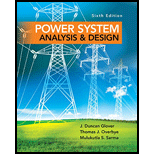
Power System Analysis and Design (MindTap Course List)
6th Edition
ISBN: 9781305632134
Author: J. Duncan Glover, Thomas Overbye, Mulukutla S. Sarma
Publisher: Cengage Learning
expand_more
expand_more
format_list_bulleted
Concept explainers
Question
Chapter 9, Problem 9.57P
To determine
To explain: The reason for the phase angle on one phase is always zeroduring the line to ground fault.
Expert Solution & Answer
Trending nowThis is a popular solution!

Students have asked these similar questions
Please solve this question step by step handwritten solution and do not use chat gpt or other ai tools thank you
Please solve this questions step by step detailed and handwritten, do not use chat gpt or other ai tools thanks!
Please solve this questions step by step detailed and handwritten, do not use chat gpt or other ai tools thanks!
Chapter 9 Solutions
Power System Analysis and Design (MindTap Course List)
Knowledge Booster
Learn more about
Need a deep-dive on the concept behind this application? Look no further. Learn more about this topic, electrical-engineering and related others by exploring similar questions and additional content below.Similar questions
- Please solve this question step by step with explanation and handwritten solution please do not use chat gpt or other ai tools thanksarrow_forwardPlease solve this question fully step by step handwritten and do not use chat gpt or any ai tools thanksarrow_forwardPlease solve this question step by step hand written solution and do not use chat gpt or any ai tools thanks!arrow_forward
- Please Solve this question step by step handwritten solution and do not use chat gpt or any ai tools thanks!arrow_forwardPlease solve this question step by step handrwitten solution and do not use chat gpt or any ai tools thanks.arrow_forwardplease help with the question and the following attached with the question. This is a homework practice help pleasearrow_forward
arrow_back_ios
SEE MORE QUESTIONS
arrow_forward_ios
Recommended textbooks for you
 Power System Analysis and Design (MindTap Course ...Electrical EngineeringISBN:9781305632134Author:J. Duncan Glover, Thomas Overbye, Mulukutla S. SarmaPublisher:Cengage Learning
Power System Analysis and Design (MindTap Course ...Electrical EngineeringISBN:9781305632134Author:J. Duncan Glover, Thomas Overbye, Mulukutla S. SarmaPublisher:Cengage Learning

Power System Analysis and Design (MindTap Course ...
Electrical Engineering
ISBN:9781305632134
Author:J. Duncan Glover, Thomas Overbye, Mulukutla S. Sarma
Publisher:Cengage Learning

Fault Analysis in Power Systems part 1a; Author: GeneralPAC: Power System Tutorials;https://www.youtube.com/watch?v=g8itg4MOjok;License: Standard youtube license